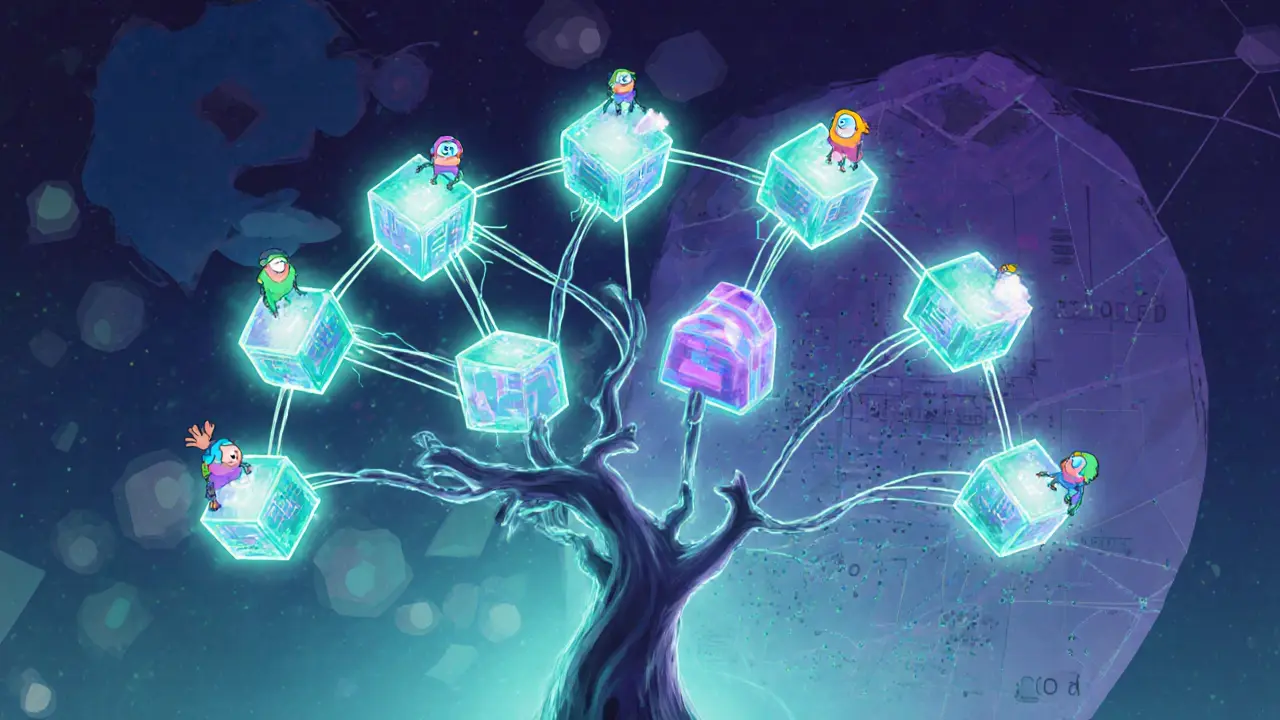IPFS File Storage Simulator
When you hear IPFS is a decentralized, peer‑to‑peer file system that stores data by its content rather than by location, you might wonder how it actually moves files around.
TL;DR
- IPFS splits files into blocks, hashes each block, and gives the whole file a unique Content Identifier (CID).
- Blocks are stored on many peer nodes that form a global Distributed Hash Table (DHT).
- To retrieve a file, you request its CID; the network finds any node holding the blocks and assembles them.
- Advantages: no single point of failure, built‑in deduplication, censorship resistance.
- Getting started: install an IPFS client or use a public gateway.
What Makes IPFS Different?
Traditional web URLs point to a server’s address. If that server disappears, the link breaks - a problem known as “link rot”. IPFS flips this model. Instead of locating a server, you locate the content itself. That shift is powered by three core ideas: content addressing, a peer‑to‑peer network, and a global Distributed Hash Table (DHT) that maps content hashes to the nodes that store them.
From File to CID: The Journey Inside IPFS
When you add a file to IPFS, the system first breaks it into small blocks (default size is 256KB). Each block is fed into a cryptographic hash - today the default is SHA‑256. The hash produces a 256‑bit fingerprint, which is then encoded in Base58 (or Base32 for newer CIDs). All block hashes are collected into a Merkle‑DAG (directed acyclic graph) and the root hash becomes the file’s Content Identifier (CID).
The CID looks like a random string, for example QmXoypizjW3WknFiJnKLwHCnL72vedxjQkDDP1mXWo6uco. That string is the only thing you need to retrieve the file later; you never need to remember an IP address or a server name.
How the Network Finds Your Data
Every node that runs the IPFS software participates in the DHT. When a node stores a block, it announces the block’s hash to the DHT. When you ask for a CID, your local node queries the DHT: “Which peers have block X?” The DHT returns a list of node IDs, and your node opens direct connections to them, pulling the blocks in parallel. Because many nodes may hold the same block (thanks to deduplication), the download can be faster than fetching from a single server.

Comparison: IPFS vs HTTP vs BitTorrent
| Feature | IPFS | HTTP (Web servers) | BitTorrent |
|---|---|---|---|
| Addressing | Content‑addressed (CID) | Location‑addressed (URL) | Info‑hash (content‑addressed) |
| Network model | Global P2P DHT | Client‑server | P2P swarms per torrent |
| Deduplication | Automatic (identical blocks stored once per node) | None (each server stores its own copy) | None at protocol level |
| Censorship resistance | High - any node can serve the content | Low - depends on server | Medium - depends on swarm size |
| Typical use case | Static website assets, decentralized apps, data permanence | Dynamic websites, APIs | Large file distribution (e.g., Linux ISOs) |
Practical Steps: Adding and Retrieving Files
- Download the IPFS desktop client or install the CLI (`ipfs install`).
- Initialize your node with
ipfs init. This creates a local repo and a peer ID. - Add a file:
ipfs add myphoto.jpg. The command returns a CID likeQm.... - Share the CID with anyone who wants the file.
- To fetch, run
ipfs cat Qm...or openhttps://ipfs.io/ipfs/Qm...via a public gateway.
If you don’t want to run a node, you can rely on public gateways (e.g., https://gateway.ipfs.io). Gateways act as HTTP front‑ends: they receive a CID via the URL, query the DHT, and serve the content over traditional HTTP.
Why Content Addressing Guarantees Integrity
Because the CID is derived from the file’s hash, any alteration changes the hash, producing a new CID. When you request the original CID, the network will only return blocks that match the exact hash. This makes tampering detectable without a central authority. For developers, this also means you can pin a specific version of a file and be absolutely sure you’re getting the same data every time.
Common Pitfalls and Best Practices
- Pinning: By default, a node may garbage‑collect blocks it doesn’t need. Use
ipfs pin add <CID>to keep important data available on your node. - Availability: If only one node stores a CID, the file disappears when that node goes offline. Consider using a pinning service (e.g., Pinata, Infura) for critical data.
- File size limits: Very large files are split into many blocks; retrieving them may require many peers. Use
ipfs add -rfor directories to keep related files together. - Privacy: Public CIDs are visible to anyone. For private data, encrypt the file first or use a private IPFS network.
Future Outlook: IPFS in the Web3 Era
As decentralized applications (dApps) proliferate, they need a storage layer that doesn’t rely on centralized cloud providers. IPFS is the de‑facto standard for this purpose. Combined with blockchain anchors (e.g., storing a CID on Ethereum), you get both immutability (blockchain) and efficient distribution (IPFS). By 2025, many NFT platforms already store the actual media on IPFS, ensuring that the artwork remains accessible even if the original creator’s server disappears.

Frequently Asked Questions
Do I need to run my own IPFS node to use the network?
No. You can interact with IPFS through public gateways or by using a lightweight client that connects to remote nodes. Running your own node gives you more control and contributes to network resilience, but it’s optional for casual use.
How is data stored securely on IPFS?
Security comes from content addressing. Each block’s hash guarantees integrity; if a block is altered, its hash changes and the CID no longer matches. For confidentiality, encrypt the file before adding it to IPFS, because the network itself is public.
What happens if all nodes storing a CID go offline?
The content becomes unavailable until at least one node pins or republishes the data. To avoid loss, use pinning services or replicate the CID across multiple trusted nodes.
Can IPFS replace traditional cloud storage?
For static assets, backups, and decentralized apps, IPFS offers clear benefits. However, for dynamic workloads that require low‑latency writes, transactional databases, or fine‑grained access controls, traditional cloud services still dominate. Many teams use a hybrid approach.
Is there a cost to store data on IPFS?
Running a node is free apart from bandwidth and storage costs you incur. If you rely on third‑party pinning services, they charge per GB per month. Public gateways are typically free for casual use, but heavy traffic may require a paid plan.







Write a comment